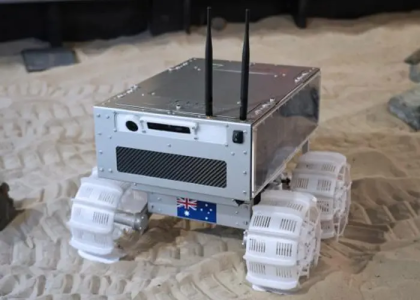Once we only watched the space race—now Aussies are part of it with our own rover
By
Maan
- Replies 0
An Australian-made creation was preparing to make history far beyond Earth.
Nicknamed Roo-ver, the robot was set to become the first Moon rover designed and built in the country.
The mission promised to place Australia at the forefront of international space exploration.
NASA tasked the rover with studying the lunar surface and gathering data to support future exploration, with hopes its findings would help lay the groundwork for a sustainable human presence in space.
Industry and Innovation and Science Minister Tim Ayres said: ‘This is one of the most specialised robotics and advanced manufacturing projects in the country.’
‘It’s accelerating the development of Australia’s advanced technical capabilities and deepening local manufacturing expertise,’ he said.
‘These capabilities will not only strengthen Australia’s space sector but also enhance innovation across industries and boost the STEM workforce needed to meet future challenges.’
The rover was scheduled to travel via the American company’s Commercial Lunar Payload Services (CLPS) initiative, though not until the end of the decade.
The project marked the furthest any Australian-built object had ever travelled in space, making it a landmark moment for the nation’s scientific and technological progress.
Roo-ver would also carry an integrated NASA payload, designed to demonstrate technology for both scientific and exploration purposes.
Head of the Australian Space Agency, Enrico Palermo, called the mission ‘cutting edge’ and a sign of the country’s capabilities.
‘Establishing a sustainable human presence on the Moon and Mars is a key focus of the international space community over the coming decades, and the work we’re doing with Roo-ver centres Australia in that foundational work,’ he said.
The rover was designed by the ELO2 consortium, working in partnership with the Australian Space Agency, and bringing together 20 local organisations with expertise in robotics and advanced technology.
ELO2 Consortium Director Ben Sorensen said: ‘Australia has a long history supporting international space exploration efforts.’
‘The experience delivered through the Roo-ver project will help us grow our space industry, create hi-tech jobs, and translate technology to support productivity and competitiveness of our other industries including agriculture, mining, defence.’
The government committed $42 million to the project, funding the design, development, build, and operation of Roo-ver.
Space exploration isn’t the only area where homegrown innovation is making headlines.
Closer to everyday life, new technology is changing the way we stay connected right here on Earth.
One recent breakthrough shows how the sky above us is becoming part of our daily communications.
Read more: Telstra launches Australia's first direct-to-satellite text messaging service

Could this mission be the moment that firmly establishes Australia as a leader in the new space age?
Nicknamed Roo-ver, the robot was set to become the first Moon rover designed and built in the country.
The mission promised to place Australia at the forefront of international space exploration.
NASA tasked the rover with studying the lunar surface and gathering data to support future exploration, with hopes its findings would help lay the groundwork for a sustainable human presence in space.
Industry and Innovation and Science Minister Tim Ayres said: ‘This is one of the most specialised robotics and advanced manufacturing projects in the country.’
‘It’s accelerating the development of Australia’s advanced technical capabilities and deepening local manufacturing expertise,’ he said.
‘These capabilities will not only strengthen Australia’s space sector but also enhance innovation across industries and boost the STEM workforce needed to meet future challenges.’
The rover was scheduled to travel via the American company’s Commercial Lunar Payload Services (CLPS) initiative, though not until the end of the decade.
The project marked the furthest any Australian-built object had ever travelled in space, making it a landmark moment for the nation’s scientific and technological progress.
Roo-ver would also carry an integrated NASA payload, designed to demonstrate technology for both scientific and exploration purposes.
Head of the Australian Space Agency, Enrico Palermo, called the mission ‘cutting edge’ and a sign of the country’s capabilities.
‘Establishing a sustainable human presence on the Moon and Mars is a key focus of the international space community over the coming decades, and the work we’re doing with Roo-ver centres Australia in that foundational work,’ he said.
The rover was designed by the ELO2 consortium, working in partnership with the Australian Space Agency, and bringing together 20 local organisations with expertise in robotics and advanced technology.
ELO2 Consortium Director Ben Sorensen said: ‘Australia has a long history supporting international space exploration efforts.’
‘The experience delivered through the Roo-ver project will help us grow our space industry, create hi-tech jobs, and translate technology to support productivity and competitiveness of our other industries including agriculture, mining, defence.’
The government committed $42 million to the project, funding the design, development, build, and operation of Roo-ver.
Space exploration isn’t the only area where homegrown innovation is making headlines.
Closer to everyday life, new technology is changing the way we stay connected right here on Earth.
One recent breakthrough shows how the sky above us is becoming part of our daily communications.
Read more: Telstra launches Australia's first direct-to-satellite text messaging service
Key Takeaways
- Roo-ver was Australia’s first ever Moon rover.
- The robot was set to fly as part of NASA’s CLPS program at the end of the decade.
- It would carry a NASA payload to test exploration and scientific technologies.
- The Australian government invested $42 million in its design, construction, and operation.
Could this mission be the moment that firmly establishes Australia as a leader in the new space age?








